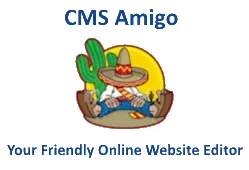This guide shows the full flow: pick a template, edit visually, manage images, and publish safely to your host.
Overview
CMS Amigo is a lightweight visual editor for clean HTML/CSS sites. You can start from our templates or bring your own, then publish by exporting files or using built-in SFTP (Pro/Agency).
Quick start
- Open the editor and choose a Starter Template (or import your HTML/CSS).
- Edit the page text, buttons, and links inline.
- Replace images (see “Images & responsiveness” below).
- Preview in a new tab; check headings, links, and mobile layout.
- Publish:
- Export (Demo/Starter): upload via your host’s File Manager or Git.
- SFTP (Pro/Agency): save server credentials and deploy from the editor.
Editing pages
Most content is editable in place. Use the sidebar (if present) for sections/components.
- Copy/paste blocks: duplicate a section to iterate without losing the original.
- Links: prefer relative paths (e.g.,
pricing.html) for portability. - Anchors: add
idto headings; our CSS offsets anchors for a sticky topbar.
Images & responsiveness
Use WebP/AVIF, keep aspect ratios, and add responsive sources for sharper cards and heroes.
<img
src="images/kitchen-1200.webp"
srcset="images/kitchen-800.webp 800w,
images/kitchen-1200.webp 1200w"
sizes="(max-width: 980px) 100vw, 600px"
width="1200" height="800"
alt="Finished kitchen renovation in Toronto"
loading="lazy" decoding="async"><head> so LCP is fetched early.Using templates
Each template ships as plain HTML/CSS. Replace copy and images; keep class names to retain layout.
<section class="hero hero--overlay">
<img class="hero-media" src="images/toronto-reno-hero-1600.webp"
width="2000" height="1200" alt="" fetchpriority="high" decoding="async">
<div class="container hero-inner">
<h1>Project headline</h1>
<p>Short value statement…</p>
</div>
</section>Publishing (Export / SFTP)
Export: download files and upload to your host (cPanel, Plesk, or Git). SFTP: use a deploy-only user and limited permissions.
# SFTP example (command-line)
sftp deploy@example.com
# put your exported files into /public_html or your web root
put -r site/* /public_html
byeBackups & rollback
- Local: keep dated export zips.
- Server: enable host snapshots or versioned deploys.
- Git (optional): commit exported files and tag releases.
git init
git add .
git commit -m "Initial"
git tag -a v1.0 -m "Launch"
# later… git checkout v1.0 # rollbackPerformance & LCP
- Use
fetchpriority="high"on the hero & preload if background-image. - Lazy-load non-critical images (
loading="lazy") and addwidth/heightto prevent CLS. - Serve local AVIF/WebP; set long cache headers (your
.htaccessalready covers this).
Troubleshooting
- Lightbox tiny? Ensure the overlay is outside the templates container and your CSS includes the lightbox rules (max-width 96vw / 90vh).
- Layout breaks after editing hero <img>? Don’t put HTML comments inside a tag; ensure the tag closes with
>. - Sticky topbar overlaps anchors? Our section sets
scroll-margin-topusing--topbar-h.
Need more? See the FAQ for plan details and editor tips.
